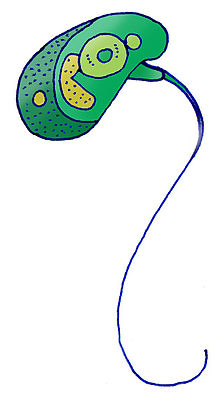| Micromonas | |
|---|---|

| |
| Micromonas pusilla | |
| Scientific classification | |
| Clade: | Viridiplantae |
| Division: | Chlorophyta |
| Class: | Mamiellophyceae |
| Order: | Mamiellales |
| Family: | Mamiellaceae |
| Genus: | Micromonas Manton & Parke 1960 |
| Species | |
| |
Micromonas is a genus of green algae in the family Mamiellaceae.[1][2]
Micromonas is a widespread prasinophyte alga that is very small in size, motile, and phototactic.[3] Before characterization and naming of a second species, Micromonas commoda[4] through genome analysis,[5] Micromonas pusilla was considered to be the only species in the genus.[6][7] This led to a disproportionate amount of research discussing a single species and the suggestion that it was the dominant photosynthetic picoeukaryote in some marine ecosystems.[8] Unlike many marine algae, this single species was thought to be distributed widely in both warm and cold waters, but genome sequencing confirmed indications from single-gene studies[9][10] that its global distribution really reflected presence of multiple species occupying different niches in the ocean.[5][3]
Some studies have divided Micromonas pusilla into 3 to 5 different clades despite their similarity in morphologies and habitats.[11][12] Varying ratios of clades contribute to the M. pusilla population throughout the marine ecosystem leading to the hypothesis of clades arising based on niche occupation and susceptibility to virus infection.[12] Other studies have established the presence of at least seven phylogenetically distinct species for which global sequence analyses are beginning to delineate clear differences in the ocean regions they inhabit, with only some of the species actually co-occurring in the same environment.[13][14][15]
- ^ See the NCBI webpage on Micromonas. Data extracted from the NCBI taxonomy resources, National Center for Biotechnology Information, retrieved 2007-03-19
- ^ Micromonas Manton & Parke, 1960, non Borrel, 1902, World Register of Marine Species, accessed March 6, 2010
- ^ a b Genomes of Two Strains of Micromonas Algae Show Surprising Diversity Archived 2011-07-07 at the Wayback Machine, Alternative Energy Newswire, April 10, 2009
- ^ van Baren, Marijke J.; Bachy, Charles; Reistetter, Emily Nahas; Purvine, Samuel O.; Grimwood, Jane; Sudek, Sebastian; Yu, Hang; Poirier, Camille; Deerinck, Thomas J. (2016-03-31). "Evidence-based green algal genomics reveals marine diversity and ancestral characteristics of land plants". BMC Genomics. 17: 267. doi:10.1186/s12864-016-2585-6. ISSN 1471-2164. PMC 4815162. PMID 27029936.
- ^ a b Worden, Alexandra Z.; et al. (2009-04-10). "Green Evolution and Dynamic Adaptations Revealed by Genomes of the Marine Picoeukaryotes Micromonas". Science. 324 (5924): 268–272. Bibcode:2009Sci...324..268W. doi:10.1126/science.1167222. ISSN 0036-8075. PMID 19359590. S2CID 206516961.
- ^ Cite error: The named reference
:3was invoked but never defined (see the help page). - ^ Borowitzka, Michael A.; Beardall, John; Raven, John A. (2016-03-21). The physiology of microalgae. Cham: Springer International. ISBN 9783319249452. OCLC 945445086.
- ^ Not, F; Latasa, M; Marie, D; Cariou, T; Vaulot, D; Simon, N (Jul 2004), "A Single Species, Micromonas pusilla (Prasinophyceae), Dominates the Eukaryotic Picoplankton in the Western English Channel", Applied and Environmental Microbiology, 70 (7): 4064–72, Bibcode:2004ApEnM..70.4064N, doi:10.1128/AEM.70.7.4064-4072.2004, ISSN 0099-2240, PMC 444783, PMID 15240284
- ^ Šlapeta, Jan; López-García, Purificación; Moreira, David (2006). "Global Dispersal and Ancient Cryptic Species in the Smallest Marine Eukaryotes". Molecular Biology and Evolution. 23 (1): 23–29. doi:10.1093/molbev/msj001. ISSN 1537-1719. PMID 16120798.
- ^ Worden, Az (2006). "Picoeukaryote diversity in coastal waters of the Pacific Ocean". Aquatic Microbial Ecology. 43: 165–175. doi:10.3354/ame043165. ISSN 0948-3055.
- ^ Foulon, Elodie; Not, Fabrice; Jalabert, Fabienne; Cariou, Thierry; Massana, Ramon; Simon, Nathalie (1 September 2008). "Ecological niche partitioning in the picoplanktonic green alga Micromonas pusilla: evidence from environmental surveys using phylogenetic probes". Environmental Microbiology. 10 (9): 2433–2443. Bibcode:2008EnvMi..10.2433F. doi:10.1111/j.1462-2920.2008.01673.x. PMID 18537812.
- ^ a b Baudoux, A.-C.; Lebredonchel, H.; Dehmer, H.; Latimier, M.; Edern, R.; Rigaut-Jalabert, F.; Ge, P.; Guillou, L.; Foulon, E.; Bozec, Y.; Cariou, T.; Desdevises, Y.; Derelle, E.; Grimsley, N.; Moreau, H.; Simon, N. (1 October 2015). "Interplay between the genetic clades of Micromonas and their viruses in the Western English Channel" (PDF). Environmental Microbiology Reports. 7 (5): 765–773. Bibcode:2015EnvMR...7..765B. doi:10.1111/1758-2229.12309. PMID 26081716.
- ^ Eckmann, Charlotte A.; Eberle, Jessica S.; Wittmers, Fabian; Wilken, Susanne; Bergauer, Kristin; Poirier, Camille; Blum, Marguerite; Makareviciute-Fichtner, Kriste; Jimenez, Valeria; Bachy, Charles; Vermeij, Mark J. A.; Worden, Alexandra Z. (2023). "Eukaryotic algal community composition in tropical environments from solar salterns to the open sea". Frontiers in Marine Science. 10. doi:10.3389/fmars.2023.1131351. ISSN 2296-7745.
- ^ Strauss, Jan; Choi, Chang Jae; Grone, Jonathan; Wittmers, Fabian; Jimenez, Valeria; Makareviciute-Fichtner, Kriste; Bachy, Charles; Jaeger, Gualtiero Spiro; Poirier, Camille; Eckmann, Charlotte; Spezzano, Rachele; Löscher, Carolin R.; Sarma, V. V. S. S.; Mahadevan, Amala; Worden, Alexandra Z. (2023). "The Bay of Bengal exposes abundant photosynthetic picoplankton and newfound diversity along salinity-driven gradients". Environmental Microbiology. 25 (11): 2118–2141. Bibcode:2023EnvMi..25.2118S. doi:10.1111/1462-2920.16431. ISSN 1462-2912. PMID 37311449.
- ^ Bachy, Charles; Wittmers, Fabian; Muschiol, Jan; Hamilton, Maria; Henrissat, Bernard; Worden, Alexandra Z. (2022). "The Land–Sea Connection: Insights Into the Plant Lineage from a Green Algal Perspective". Annual Review of Plant Biology. 73 (1): 585–616. doi:10.1146/annurev-arplant-071921-100530. ISSN 1543-5008. PMID 35259927.